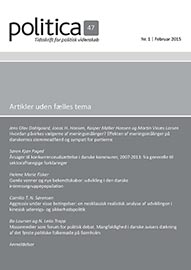Aggressiv under visse betingelser: en neoklassisk realistisk analyse af udviklingen i kinesisk udenrigs- og sikkerhedspolitik
DOI:
https://doi.org/10.7146/politica.v47i1.131480Resumé
Kina anses i stigende grad som en aggressiv stormagt. Særligt kinesiske aktiviteter i det Sydkinesiske og Østkinesiske Hav fremhæves som eksempler på et generelt mere selvsikkert og selvhævdende Kina. Er dette tilfældet? Nej. Der er ikke en klar linje i eller strategi bag udviklingen i kinesisk udenrigs- og sikkerhedspolitik. En neoklassisk realistisk analyse viser, hvordan de igangværende ændringer i den overordnede magtbalance drevet af et økonomisk og militært stærkere Kina opstiller et nyt handlerum for kinesisk udenrigs- og sikkerhedspolitik. Beijing kan ikke længere free ride og “ligge lavt” i det internationale system. Kinesiske lederes hensyn til at sikre egen indenrigspolitisk legitimitet trækker samtidig kinesisk udenrigs- og sikkerhedspolitik i forskellige retninger. I de tilfælde hvor indenrigspolitisk nationalistisk pres mobiliseres, vil politikken blive trukket i en mere aggressiv retning.
Referencer
Booth, Ken (red.) (2009). The King of Thought: theory, the subject, and Waltz. Part I: perspectives on structural realism. Special Issue of International Relations 23 (2): 179-306.
Elman, Colin (1996). Horses for courses: why not neorealist theories of foreign policy? Security Studies 6 (1): 7-53.
Fravel, M. Taylor (2008). Strong Borders, Secure Nation. Cooperation and Conflict in China’s Territorial Disputes. Princeton: Princeton University Press.
Friedberg, Aaron (2012). A Contest for Supremacy: China, America and the Struggle for Mastery in Asia. New York: W. W. Norton.
Goldstein, Avery (2005). Rising to the Challenge: China’s Grand Strategy and International Security. Redwood City: Stanford University Press.
Hansen, Birthe (2011). Unipolarity and World Politics: A Theory and Its Implications. London: Routledge.
He, Yinan (2007). History, Chinese nationalism and the emerging Sino-Japanese conflict. Journal of Contemporary China 16 (50): 1-24.
Howell, Jude (2012). Civil society, corporatism and capitalism in China. The Journal of Comparative Asian Development 11 (2): 271-297.
Johnston, Alastair Iain (2013). How new and assertive is China’s new assertiveness? International Security 37 (4): 7-48.
Lampton, David M. (2014). Following the Leader. Berkeley and Los Angeles: University of California Press.
Lobell, Steven E., Norrin M. Ripsman og Jeffrey W. Taliaferro (2009). Neoclassical Realism, The State, and Foreign Policy. Cambridge: Cambridge University Press.
Mearsheimer, John J. (2001). The Tragedy of Great Power Politics. New York: W. W. Norton
Mearsheimer, John J. (2007). Structural realism, pp. 71-88 i Tim Dunne, Milja Kurki og Steve Smith (red.), International Relations Theories. Discipline and Diversity. Oxford: Oxford University Press.
Mearsheimer, John J. (2010). The gathering storm: China’s challenge to US’s power in Asia. The Chinese Journal of International Politics 3: 381-396.
Morgenthau, Hans J. (2006 [1948]). Politics Among Nations: The Struggle for Power and Peace, 7th ed. (revised by Kenneth W. Thompson og W. David Clinton). New York: McGraw-Hill/Irwin.
Paul, T. V. (2004). Introduction: the enduring axioms of balance of power theory and their contemporary relevance, pp. 1-25 i T. V. Paul, James J. Wirtz og Michael Fortmann (red), Balance of Power. Theory and Practice in the 21st Century. Redwood City: Stanford University Press.
Qin, Yaqing (2010). Struggle for identity: a political psychology of China’s rise, pp. 249-269 i Brantly Womack (red.), China’s Rise in Historical Perspective. New York: Rowman & Littlefield.
Rose, Gideon (1998). Neoclassical realism and theories of foreign policy. World Politics 51 (1): 144-177.
Rothkopf, David (2011). The China threat: considering the growing consensus. Foreign Policy 18. januar http://rothkopf.foreignpolicy.com/posts/2011/01/18/the_china_threat_considering_the_growing_consensus (28. januar 2014).
Scobell, Andrew og Scott W. Harold (2013). An “assertive” China? Insights from interviews. Asian Security 9 (2): 111-131.
Schweller, Randall (2006). Unanswered Threats: Political Constraints on the Balance of Power. Princeton: Princeton University Press.
Schweller, Randall og Pu Xiaoyu (2011). After unipolarity: China’s visions of international order in an era of U.S. decline. International Security 36 (1): 41-72.
Swaine, Michael D. (2010). Perceptions of an assertive China. China Leadership Monitor 32: 1-19.
Swaine, Michael D. (2012). Chinese leadership and elite response to the US Pacific pivot. China Leadership Monitor 38: 1-26.
Sørensen, Camilla T. N. (2008). The Contingent Rise of China. The Development in Chinese Post-Cold War Security Policy. Ph.d.-afhandling 2008/5, Institut for Statskundskab, Københavns Universitet.
Taliaferro, Jeffrey W. (2006). State building for future wars: neoclassical realism and the resource-extractive state. Security Studies 15 (3): 464-495.
Waltz, Kenneth (1979). Theory of International Politics. Reading: Addison-Wesley.
Wang, Fei-Ling (2005). Beijing’s incentive structure: the pursuit of preservation, prosperity, and power, pp. 19-50 i Yong Deng og Fei-Ling Wang (red.), China Rising. Power and Motivation in Chinese Foreign Policy. Lanham: Rowman & Littlefield.
Wivel, Anders (2002). Realism efter Waltz: udvikling eller afvikling? Politica 34 (4): 431-448.
Wohlforth, William C. (1999). The stability of a unipolar world. International Security 24 (1): 5-41.
Wohlforth, William C. (2008). Realism and foreign policy, pp. 31-48 i Steven Smith, Amelia Hadfield og Tim Dunne (red.), Foreign Policy. Theories. Actors. Cases. Oxford: Oxford University Press.
Zhao, Suisheng (2013). Foreign policy implications of chinese nationalism revisited. The strident turn. Journal of Contemporary China 22 (82): 535-553.
Downloads
Publiceret
Citation/Eksport
Nummer
Sektion
Licens
LicensOphavsretten tilhører Politica. Materialet må ikke bruges eller distribueres i kommercielt øjemed.





